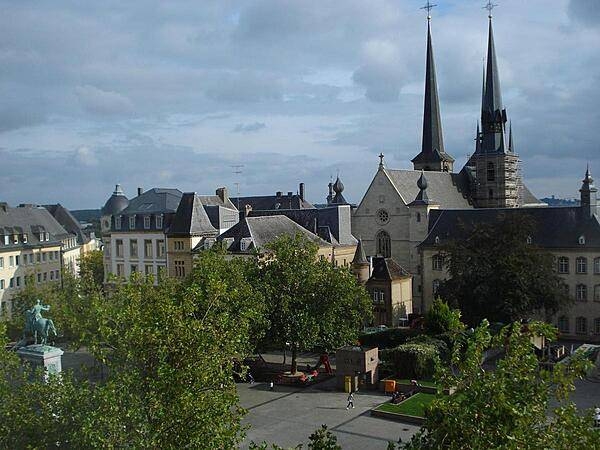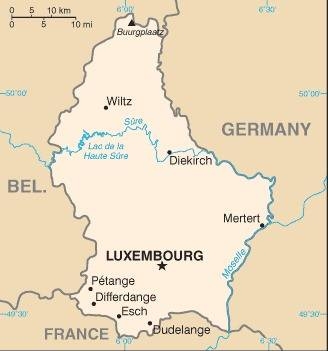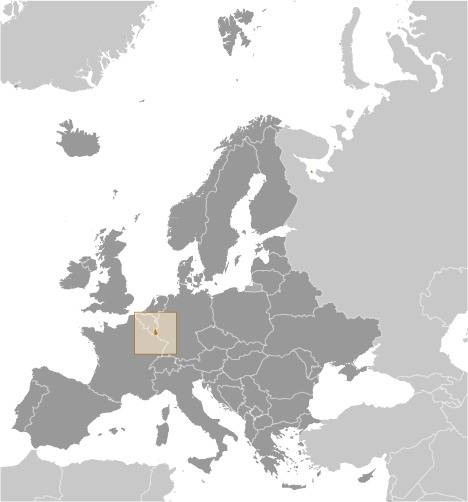Luxembourg
Introduction
Background
Founded in 963, Luxembourg became a grand duchy in 1815 and an independent state under the Netherlands. It lost more than half of its territory to Belgium in 1839 but gained a larger measure of autonomy. In 1867, Luxembourg attained full independence under the condition that it promise perpetual neutrality. Overrun by Germany in both world wars, it ended its neutrality in 1948 when it entered into the Benelux Customs Union and when it joined NATO the following year. In 1957, Luxembourg became one of the six founding countries of the EEC (later the EU), and in 1999 it joined the euro currency zone.
Visit the Definitions and Notes page to view a description of each topic.
Geography
Location
Western Europe, between France and Germany
Geographic coordinates
49 45 N, 6 10 E
Map references
Europe
Area - comparative
slightly smaller than Rhode Island; about half the size of Delaware
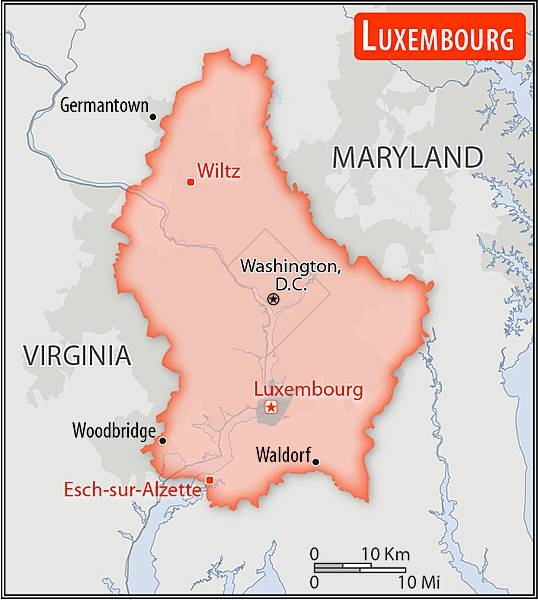
Land boundaries
total: 327 km
border countries (3): Belgium 130 km; France 69 km; Germany 128 km
Coastline
0 km (landlocked)
Maritime claims
none (landlocked)
Climate
modified continental with mild winters, cool summers
Terrain
mostly gently rolling uplands with broad, shallow valleys; uplands to slightly mountainous in the north; steep slope down to Moselle flood plain in the southeast
Elevation
highest point: Buurgplaatz 559 m
lowest point: Moselle River 133 m
mean elevation: 325 m
Natural resources
iron ore (no longer exploited), arable land
Land use
agricultural land: 50.7% (2018 est.)
arable land: 24% (2018 est.)
permanent crops: 0.6% (2018 est.)
permanent pasture: 26.1% (2018 est.)
forest: 33.5% (2018 est.)
other: 15.8% (2018 est.)
Irrigated land
0 sq km (2012)
Major watersheds (area sq km)
Atlantic Ocean drainage: Rhine-Maas (198,735 sq km)
Population distribution
most people live in the south, on or near the border with France
Natural hazards
occasional flooding
Geography - note
landlocked; the only grand duchy in the world
People and Society
Nationality
noun: Luxembourger(s)
adjective: Luxembourg
Ethnic groups
Luxembourger 52.9%, Portuguese 14.5%, French 7.6%, Italian 3.7%, Belgian 3%, German 2%, Spanish 1.3%, Romania 1%, other 14% (2022 est.)
note: data represent population by nationality
Languages
Luxembourgish (official administrative and judicial language and national language (spoken vernacular)) 55.8%, Portuguese 15.7%, French (official administrative, judicial, and legislative language) 12.1%, German (official administrative and judicial language) 3.1%, Italian 2.9%, English 2.1%, other 8.4% (2011 est.)
Religions
Christian (predominantly Roman Catholic) 70.6%, Muslim 2.3%, other (includes Buddhist, folk religions, Hindu, Jewish) 0.4%, unaffiliated 26.7% (2020 est.)
Age structure
0-14 years: 16.73% (male 54,099/female 51,004)
15-24 years: 11.78% (male 37,946/female 36,061)
25-54 years: 43.93% (male 141,535/female 134,531)
55-64 years: 12.19% (male 39,289/female 37,337)
65 years and over: 15.37% (male 43,595/female 52,984) (2020 est.)
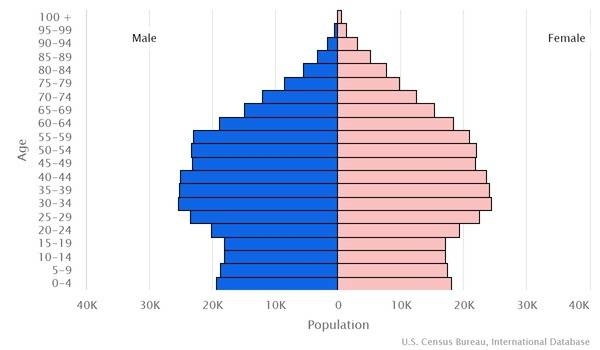
Dependency ratios
total dependency ratio: 44.2
youth dependency ratio: 23
elderly dependency ratio: 21.3
potential support ratio: 4.7 (2021 est.)
Median age
total: 39.5 years
male: 38.9 years
female: 40 years (2020 est.)
Population distribution
most people live in the south, on or near the border with France
Urbanization
urban population: 92.1% of total population (2023)
rate of urbanization: 1.43% annual rate of change (2020-25 est.)
Major urban areas - population
120,000 LUXEMBOURG (capital) (2018)
Sex ratio
at birth: 1.06 male(s)/female
0-14 years: 1.06 male(s)/female
15-24 years: 1.05 male(s)/female
25-54 years: 1.05 male(s)/female
55-64 years: 1.06 male(s)/female
65 years and over: 0.7 male(s)/female
total population: 1.02 male(s)/female (2022 est.)
Mother's mean age at first birth
31 years (2020 est.)
Maternal mortality ratio
5 deaths/100,000 live births (2017 est.)
country comparison to the world: 168Infant mortality rate
total: 3.25 deaths/1,000 live births
male: 3.65 deaths/1,000 live births
female: 2.83 deaths/1,000 live births (2022 est.)
Life expectancy at birth
total population: 82.98 years
male: 80.52 years
female: 85.58 years (2022 est.)
Drinking water source
improved: urban: 100% of population
rural: 98.6% of population
total: 99.9% of population
unimproved: urban: 0% of population
rural: 1.4% of population
total: 0.1% of population (2020 est.)
Current health expenditure
5.4% of GDP (2019)
Physicians density
3.01 physicians/1,000 population (2017)
Hospital bed density
4.3 beds/1,000 population (2019)
Sanitation facility access
improved: urban: 100% of population
rural: 99.9% of population
total: 100% of population
unimproved: urban: 0% of population
rural: 0.1% of population
total: 0% of population (2020 est.)
Alcohol consumption per capita
total: 11 liters of pure alcohol (2019 est.)
beer: 4.04 liters of pure alcohol (2019 est.)
wine: 4.73 liters of pure alcohol (2019 est.)
spirits: 2.14 liters of pure alcohol (2019 est.)
other alcohols: 0 liters of pure alcohol (2019 est.)
Tobacco use
total: 21.1% (2020 est.)
male: 22.4% (2020 est.)
female: 19.8% (2020 est.)
Literacy
total population: NA
male: NA
female: NA
School life expectancy (primary to tertiary education)
total: 15 years
male: 15 years
female: 15 years (2020)
Youth unemployment rate (ages 15-24)
total: 16.9%
male: 17.7%
female: 16.1% (2021 est.)
Environment
Environment - current issues
air and water pollution in urban areas, soil pollution of farmland; unsustainable patterns of consumption (transport, energy, recreation, space) threaten biodiversity and landscapes
Environment - international agreements
party to: Air Pollution, Air Pollution-Heavy Metals, Air Pollution-Multi-effect Protocol, Air Pollution-Nitrogen Oxides, Air Pollution-Persistent Organic Pollutants, Air Pollution-Sulphur 85, Air Pollution-Sulphur 94, Air Pollution-Volatile Organic Compounds, Biodiversity, Climate Change, Climate Change-Kyoto Protocol, Climate Change-Paris Agreement, Comprehensive Nuclear Test Ban, Desertification, Endangered Species, Hazardous Wastes, Law of the Sea, Marine Dumping-London Convention, Marine Dumping-London Protocol, Nuclear Test Ban, Ozone Layer Protection, Ship Pollution, Tropical Timber 2006, Wetlands, Whaling
signed, but not ratified: Environmental Modification
Air pollutants
particulate matter emissions: 10.21 micrograms per cubic meter (2016 est.)
carbon dioxide emissions: 8.99 megatons (2016 est.)
methane emissions: 0.61 megatons (2020 est.)
Climate
modified continental with mild winters, cool summers
Land use
agricultural land: 50.7% (2018 est.)
arable land: 24% (2018 est.)
permanent crops: 0.6% (2018 est.)
permanent pasture: 26.1% (2018 est.)
forest: 33.5% (2018 est.)
other: 15.8% (2018 est.)
Urbanization
urban population: 92.1% of total population (2023)
rate of urbanization: 1.43% annual rate of change (2020-25 est.)
Revenue from forest resources
forest revenues: 0.01% of GDP (2018 est.)
country comparison to the world: 154Waste and recycling
municipal solid waste generated annually: 356,000 tons (2015 est.)
municipal solid waste recycled annually: 100,997 tons (2015 est.)
percent of municipal solid waste recycled: 28.4% (2015 est.)
Major watersheds (area sq km)
Atlantic Ocean drainage: Rhine-Maas (198,735 sq km)
Total water withdrawal
municipal: 43.6 million cubic meters (2017 est.)
industrial: 1.6 million cubic meters (2017 est.)
agricultural: 400,000 cubic meters (2017 est.)
Total renewable water resources
3.5 billion cubic meters (2017 est.)
Government
Country name
conventional long form: Grand Duchy of Luxembourg
conventional short form: Luxembourg
local long form: Grand Duche de Luxembourg
local short form: Luxembourg
etymology: the name derives from the Celtic "lucilem" (little) and the German "burg" (castle or fortress) to produce the meaning of the "little castle"; the name is actually ironic, since for centuries the Fortress of Luxembourg was one of Europe's most formidable fortifications; the name passed to the surrounding city and then to the country itself
Government type
constitutional monarchy
Capital
name: Luxembourg
geographic coordinates: 49 36 N, 6 07 E
time difference: UTC+1 (6 hours ahead of Washington, DC, during Standard Time)
daylight saving time: +1hr, begins last Sunday in March; ends last Sunday in October
etymology: the name derives from the Celtic lucilem (little) and the German burg (castle or fortress) to produce the meaning of the "little castle"; the name is actually ironic, since for centuries the Fortress of Luxembourg was one of Europe's most formidable fortifications; the name passed to the city that grew around the fortress
Administrative divisions
12 cantons (cantons, singular - canton); Capellen, Clervaux, Diekirch, Echternach, Esch-sur-Alzette, Grevenmacher, Luxembourg, Mersch, Redange, Remich, Vianden, Wiltz
Independence
1839 (from the Netherlands)
National holiday
National Day (birthday of Grand Duke HENRI), 23 June; note - this date of birth is not the true date of birth for any of the Royals, but the national festivities were shifted in 1962 to allow observance during a more favorable time of year
Constitution
history: previous 1842 (heavily amended 1848, 1856); latest effective 17 October 1868
amendments: proposed by the Chamber of Deputies or by the monarch to the Chamber; passage requires at least two-thirds majority vote by the Chamber in two successive readings three months apart; a referendum can be substituted for the second reading if approved by more than a quarter of the Chamber members or by 25,000 valid voters; adoption by referendum requires a majority of all valid voters; amended many times, last in 2020
Legal system
civil law system
International law organization participation
accepts compulsory ICJ jurisdiction; accepts ICCt jurisdiction
Citizenship
citizenship by birth: limited to situations where the parents are either unknown, stateless, or when the nationality law of the parents' state of origin does not permit acquisition of citizenship by descent when the birth occurs outside of national territory
citizenship by descent only: at least one parent must be a citizen of Luxembourg
dual citizenship recognized: yes
residency requirement for naturalization: 7 years
Suffrage
18 years of age; universal and compulsory
Executive branch
chief of state: Grand Duke HENRI (since 7 October 2000); Heir Apparent Prince GUILLAUME (son of the monarch, born 11 November 1981)
head of government: Prime Minister Xavier BETTEL (since 4 December 2013); Deputy Prime Minister Francois BAUSCH (since 11 October 2019); Deputy Prime Minister Daniel KERSCH (since 4 February 2020)
cabinet: Council of Ministers recommended by the prime minister, appointed by the monarch
elections/appointments: the monarchy is hereditary; following elections to the Chamber of Deputies, the leader of the majority party or majority coalition usually appointed prime minister by the monarch; deputy prime minister appointed by the monarch; prime minister and deputy prime minister are responsible to the Chamber of Deputies
Legislative branch
description: unicameral Chamber of Deputies or Chambre des Deputes (60 seats; members directly elected in multi-seat constituencies by party-list proportional representation vote; members serve 5-year terms); note - a 21-member Council of State appointed by the Grand Duke on the advice of the prime minister serves as an advisory body to the Chamber of Deputies
elections: last held on 14 October 2018 (next to be held by 31 October 2023)
election results: percent of vote by party - CSV 35%, LSAP 16.7%, DP 20%, Green Party 9%, ADR 6.7%, Pirate Party 3.3%, The Left 3.3%; seats by party - CSV 21, DP 12, LSAP 10, Green Party 9, ADR 4, Pirate Party 2, The Left 2; composition (as of September 2021) - men 40, women 20, percent of women 33.3%
Judicial branch
highest court(s): Supreme Court of Justice includes Court of Appeal and Court of Cassation (consists of 27 judges on 9 benches); Constitutional Court (consists of 9 members)
judge selection and term of office: judges of both courts appointed by the monarch for life
subordinate courts: Court of Accounts; district and local tribunals and courts
Political parties and leaders
Alternative Democratic Reform Party or ADR [Fred KEUP]
Christian Social People's Party or CSV [Claude WISELER]
Democratic Party or DP [Corinne CAHEN]
Green Party [Djuna BERNARD, Meris SEHOVIC]
Luxembourg Socialist Workers' Party or LSAP [Yves CRUCHTEN]
The Left (dei Lenk/la Gauche) [collective leadership, Central Committee]
Pirate Party [Sven CLEMENT, Marc GOERGEN]
International organization participation
ADB (nonregional member), Australia Group, Benelux, BIS, CD, CE, EAPC, EBRD, ECB, EIB, EMU, ESA, EU, FAO, FATF, IAEA, IBRD, ICAO, ICC (national committees), ICCt, ICRM, IDA, IEA, IFAD, IFC, IFRCS, ILO, IMF, IMO, Interpol, IOC, IOM, IPU, ISO, ITSO, ITU, ITUC (NGOs), MIGA, NATO, NEA, NSG, OAS (observer), OECD, OIF, OPCW, OSCE, PCA, Schengen Convention, UN, UNCTAD, UNESCO, UNHCR, UNHRC, UNIDO, UNRWA, UPU, Wassenaar Arrangement, WCO, WHO, WIPO, WMO, WTO, ZC
Diplomatic representation in the US
chief of mission: Ambassador Nicole BINTNER-BAKSHIAN (since 19 August 2021)
chancery: 2200 Massachusetts Avenue NW, Washington, DC 20008
telephone: [1] (202) 265-4171
FAX: [1] (202) 328-8270
email address and website:
washington.amb@mae.etat.lu
https://washington.mae.lu/en.html
consulate(s) general: New York, San Francisco
Diplomatic representation from the US
chief of mission: Ambassador Thomas M. BARRETT (since 10 February 2022)
embassy: 22 Boulevard Emmanuel Servais, L-2535 Luxembourg City
mailing address: 5380 Luxembourg Place, Washington DC 20521-5380
telephone: [352] 46-01-23-00
FAX: [352] 46-14-01
email address and website:
Luxembourgconsular@state.gov
https://lu.usembassy.gov/
Flag description
three equal horizontal bands of red (top), white, and light blue; similar to the flag of the Netherlands, which uses a darker blue and is shorter; the coloring is derived from the Grand Duke's coat of arms (a red lion on a white and blue striped field)
National symbol(s)
red, rampant lion; national colors: red, white, light blue
National anthem
name: "Ons Heemecht" (Our Motherland); "De Wilhelmus" (The William)
lyrics/music: Michel LENTZ/Jean-Antoine ZINNEN; Nikolaus WELTER/unknown
note: "Ons Heemecht," adopted 1864, is the national anthem, while "De Wilhelmus," adopted 1919, serves as a royal anthem for use when members of the grand ducal family enter or exit a ceremony in Luxembourg
National heritage
total World Heritage Sites: 1 (cultural)
selected World Heritage Site locales: Luxembourg City Old Quarters and Fortifications
Economy
Economic overview
This small, stable, high-income economy has historically featured solid growth, low inflation, and low unemployment. Luxembourg, the only Grand Duchy in the world, is a landlocked country in northwestern Europe surrounded by Belgium, France, and Germany. Despite its small landmass and small population, Luxembourg is the fifth-wealthiest country in the world when measured on a gross domestic product (PPP) per capita basis. Luxembourg has one of the highest current account surpluses as a share of GDP in the euro zone, and it maintains a healthy budgetary position, with a 2017 surplus of 0.5% of GDP, and the lowest public debt level in the region.
Since 2002, Luxembourg’s government has proactively implemented policies and programs to support economic diversification and to attract foreign direct investment. The government focused on key innovative industries that showed promise for supporting economic growth: logistics, information and communications technology (ICT); health technologies, including biotechnology and biomedical research; clean energy technologies, and more recently, space technology and financial services technologies. The economy has evolved and flourished, posting strong GDP growth of 3.4% in 2017, far outpacing the European average of 1.8%.
Luxembourg remains a financial powerhouse – the financial sector accounts for more than 35% of GDP - because of the exponential growth of the investment fund sector through the launch and development of cross-border funds (UCITS) in the 1990s. Luxembourg is the world’s second-largest investment fund asset domicile, after the US, with $4 trillion of assets in custody in financial institutions.
Luxembourg has lost some of its advantage as a favorable tax location because of OECD and EU pressure, as well as the "LuxLeaks" scandal, which revealed advantageous tax treatments offered to foreign corporations. In 2015, the government’s compliance with EU requirements to implement automatic exchange of tax information on savings accounts - thus ending banking secrecy - has constricted banking activity. Likewise, changes to the way EU members collect taxes from e-commerce has cut Luxembourg’s sales tax revenues, requiring the government to raise additional levies and to reduce some direct social benefits as part of the tax reform package of 2017. The tax reform package also included reductions in the corporate tax rate and increases in deductions for families, both intended to increase purchasing power and increase competitiveness.
Real GDP (purchasing power parity)
$69.72 billion (2020 est.)
$70.64 billion (2019 est.)
$69.06 billion (2018 est.)
note: data are in 2017 dollars
Real GDP growth rate
2.31% (2019 est.)
3.14% (2018 est.)
1.81% (2017 est.)
Real GDP per capita
$110,300 (2020 est.)
$113,900 (2019 est.)
$113,600 (2018 est.)
note: data are in 2017 dollars
GDP (official exchange rate)
$71.089 billion (2019 est.)
Inflation rate (consumer prices)
1.7% (2019 est.)
1.5% (2018 est.)
1.7% (2017 est.)
Credit ratings
Fitch rating: AAA (1994)
Moody's rating: Aaa (1989)
Standard & Poors rating: AAA (1994)
note: The year refers to the year in which the current credit rating was first obtained.
GDP - composition, by sector of origin
agriculture: 0.3% (2017 est.)
industry: 12.8% (2017 est.)
services: 86.9% (2017 est.)
GDP - composition, by end use
household consumption: 30.2% (2017 est.)
government consumption: 16.5% (2017 est.)
investment in fixed capital: 16.2% (2017 est.)
investment in inventories: 1.1% (2017 est.)
exports of goods and services: 230% (2017 est.)
imports of goods and services: -194% (2017 est.)
Agricultural products
milk, wheat, barley, triticale, potatoes, pork, beef, grapes, rapeseed, oats
Industries
banking and financial services, construction, real estate services, iron, metals, and steel, information technology, telecommunications, cargo transportation and logistics, chemicals, engineering, tires, glass, aluminum, tourism, biotechnology
Labor force
476,000 (2020 est.)
note: data exclude foreign workers; in addition to the figure for domestic labor force, about 150,000 workers commute daily from France, Belgium, and Germany
Labor force - by occupation
agriculture: 1.1%
industry: 20%
services: 78.9% (2013 est.)
Youth unemployment rate (ages 15-24)
total: 16.9%
male: 17.7%
female: 16.1% (2021 est.)
Population below poverty line
17.5% (2018 est.)
Gini Index coefficient - distribution of family income
34.9 (2017 est.)
26 (2005 est.)
Household income or consumption by percentage share
lowest 10%: 3.5%
highest 10%: 23.8% (2000)
Budget
revenues: 27.75 billion (2017 est.)
expenditures: 26.8 billion (2017 est.)
Public debt
23% of GDP (2017 est.)
20.8% of GDP (2016 est.)
note: data cover general government debt and include debt instruments issued (or owned) by government entities other than the treasury; the data include treasury debt held by foreign entities; the data include debt issued by subnational entities, as well as intragovernmental debt; intragovernmental debt consists of treasury borrowings from surpluses in the social funds, such as for retirement, medical care, and unemployment; debt instruments for the social funds are not sold at public auctions
Fiscal year
calendar year
Current account balance
$3.254 billion (2019 est.)
$3.296 billion (2018 est.)
Exports
$137.09 billion (2020 est.) note: data are in current year dollars
$133.59 billion (2019 est.) note: data are in current year dollars
$136.11 billion (2018 est.) note: data are in current year dollars
Exports - partners
Germany 23%, France 13%, Belgium 12%, Netherlands 6%, Italy 5% (2019)
Exports - commodities
iron and iron products, tires, cars, broadcasting equipment, clothing and apparel (2019)
Imports
$110.1 billion (2020 est.) note: data are in current year dollars
$108.29 billion (2019 est.) note: data are in current year dollars
$110.28 billion (2018 est.) note: data are in current year dollars
Imports - partners
Belgium 27%, Germany 24%, France 11%, Netherlands 5% (2019)
Imports - commodities
cars, refined petroleum, broadcasting equipment, scrap iron, aircraft (2019)
Reserves of foreign exchange and gold
$878 million (31 December 2017 est.)
$974 million (31 December 2016 est.)
Debt - external
$4,266,792,000,000 (2019 est.)
$4,581,617,000,000 (2018 est.)
Exchange rates
euros (EUR) per US dollar -
0.82771 (2020 est.)
0.90338 (2019 est.)
0.87789 (2018 est.)
0.885 (2014 est.)
0.7634 (2013 est.)
Energy
Electricity access
electrification - total population: 100% (2020)
Electricity
installed generating capacity: 1.899 million kW (2020 est.)
consumption: 6.188 billion kWh (2020 est.)
exports: 1.079 billion kWh (2020 est.)
imports: 6.543 billion kWh (2020 est.)
transmission/distribution losses: 156 million kWh (2020 est.)
Electricity generation sources
fossil fuels: 13.8% of total installed capacity (2020 est.)
nuclear: 0% of total installed capacity (2020 est.)
solar: 14.6% of total installed capacity (2020 est.)
wind: 27.7% of total installed capacity (2020 est.)
hydroelectricity: 7.5% of total installed capacity (2020 est.)
tide and wave: 0% of total installed capacity (2020 est.)
geothermal: 0% of total installed capacity (2020 est.)
biomass and waste: 36.4% of total installed capacity (2020 est.)
Coal
production: 0 metric tons (2020 est.)
consumption: 65,000 metric tons (2020 est.)
exports: 0 metric tons (2020 est.)
imports: 74,000 metric tons (2020 est.)
proven reserves: 0 metric tons (2019 est.)
Petroleum
total petroleum production: 0 bbl/day (2021 est.)
refined petroleum consumption: 63,900 bbl/day (2019 est.)
crude oil and lease condensate exports: 0 bbl/day (2018 est.)
crude oil and lease condensate imports: 0 bbl/day (2018 est.)
crude oil estimated reserves: 0 barrels (2021 est.)
Natural gas
production: 0 cubic meters (2021 est.)
consumption: 776.022 million cubic meters (2019 est.)
exports: 0 cubic meters (2021 est.)
imports: 772.624 million cubic meters (2019 est.)
proven reserves: 0 cubic meters (2021 est.)
Carbon dioxide emissions
11.308 million metric tonnes of CO2 (2019 est.)
from coal and metallurgical coke: 149,000 metric tonnes of CO2 (2019 est.)
from petroleum and other liquids: 9.564 million metric tonnes of CO2 (2019 est.)
from consumed natural gas: 1.594 million metric tonnes of CO2 (2019 est.)
Energy consumption per capita
310.068 million Btu/person (2019 est.)
country comparison to the world: 10Communications
Telephones - fixed lines
total subscriptions: 268,090 (2020 est.)
subscriptions per 100 inhabitants: 43 (2020 est.)
Telephones - mobile cellular
total subscriptions: 890,000 (2020 est.)
subscriptions per 100 inhabitants: 142 (2020 est.)
Telecommunication systems
general assessment: Luxembourg has a small telecom sector; there remains some pressure from regulatory measures, though no further reductions to fixed and mobile interconnection tariffs have been imposed through to 2024; high mobile penetration has slowed subscriber growth in the mobile market since 2005, though a recent law requiring SIM card registration has not had an adverse effect on the number of mobile subscribers despite network operators deactivating unregistered cards (2021)
domestic: fixed-line teledensity about 43 per 100 persons; nationwide mobile-cellular telephone system with market for mobile-cellular phones virtually saturated with about 142 per 100 mobile-cellular (2020)
international: country code - 352
note: the COVID-19 pandemic continues to have a significant impact on production and supply chains globally; since 2020, some aspects of the telecom sector have experienced a downturn, particularly in mobile device production; progress toward 5G implementation has resumed, as well as upgrades to infrastructure; consumer spending on telecom services has increased due to the surge in demand for capacity and bandwidth; the crucial nature of telecom services as a tool for work and school from home is still evident, and the spike in this area has seen growth opportunities for development of new tools and increased services
Broadcast media
Luxembourg has a long tradition of operating radio and TV services for pan-European audiences and is home to Europe's largest privately owned broadcast media group, the RTL Group, which operates 46 TV stations and 29 radio stations in Europe; also home to Europe's largest satellite operator, Societe Europeenne des Satellites (SES); domestically, the RTL Group operates TV and radio networks; other domestic private radio and TV operators and French and German stations available; satellite and cable TV services available
Internet users
total: 624,115 (2020 est.)
percent of population: 99% (2020 est.)
Broadband - fixed subscriptions
total: 235,155 (2020 est.)
subscriptions per 100 inhabitants: 38 (2020 est.)
Transportation
National air transport system
number of registered air carriers: 4 (2020)
inventory of registered aircraft operated by air carriers: 66
annual passenger traffic on registered air carriers: 2,099,102 (2018)
annual freight traffic on registered air carriers: 7,323,040,000 (2018) mt-km
Airports - with paved runways
total: 1
over 3,047 m: 1 (2021)
Airports - with unpaved runways
total: 1
under 914 m: 1 (2021)
Heliports
1 (2021)
Pipelines
142 km gas, 27 km refined products (2013)
Railways
total: 275 km (2014)
standard gauge: 275 km (2014) 1.435-m gauge (275 km electrified)
Merchant marine
total: 153
by type: bulk carrier 4, container ship 1, general cargo 23, oil tanker 3, other 122 (2021)
Ports and terminals
river port(s): Mertert (Moselle)
Military and Security
Military and security forces
Luxembourg Army (l'Armée Luxembourgeoise) (2022)
Military expenditures
0.6% of GDP (2022 est.)
0.5% of GDP (2021)
0.6% of GDP (2020)
0.5% of GDP (2019) (approximately $420 million)
0.5% of GDP (2018) (approximately $380 million)
Military and security service personnel strengths
approximately 900 active personnel (2022)
Military equipment inventories and acquisitions
the inventory of Luxembourg's Army is a small mix of Western-origin equipment; since 2010, it has received equipment from several European countries (2021)
Military service age and obligation
18-26 years of age for voluntary military service for men and women; no conscription (abolished 1969) (2022)
note 1: since 2003, the Army has allowed EU citizens 18-24 years of age who have been a resident in the country for at least 36 months to volunteer
note 2: as of 2019, women made up about 8% of the military's full-time personnel
Military - note
Luxembourg is a member of NATO and was one of the original 12 countries to sign the North Atlantic Treaty (also known as the Washington Treaty) in 1949
in 2015, Belgium, the Netherlands, and Luxembourg signed an agreement to conduct joint air policing of their territories; under the agreement, which went into effect in January of 2017, the Belgian and Dutch Air Forces trade responsibility for patrolling the skies over the three countries (2022)
Transnational Issues
Disputes - international
none identified
Refugees and internally displaced persons
refugees (country of origin): 6,756 (Ukraine) (as of 25 October 2022)
stateless persons: 194 (mid-year 2021)
